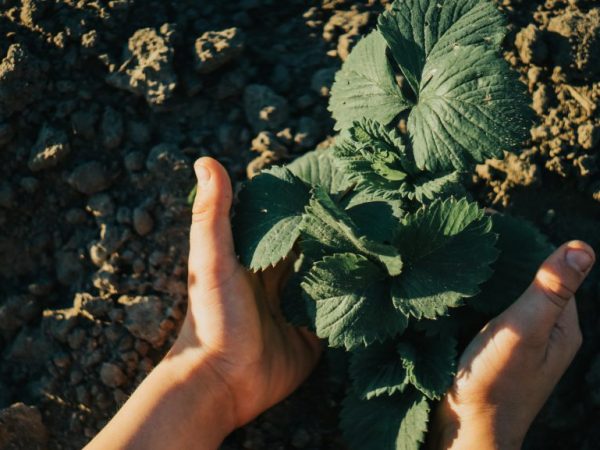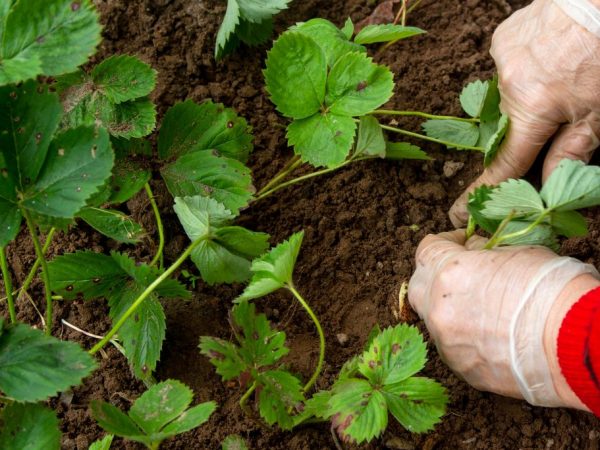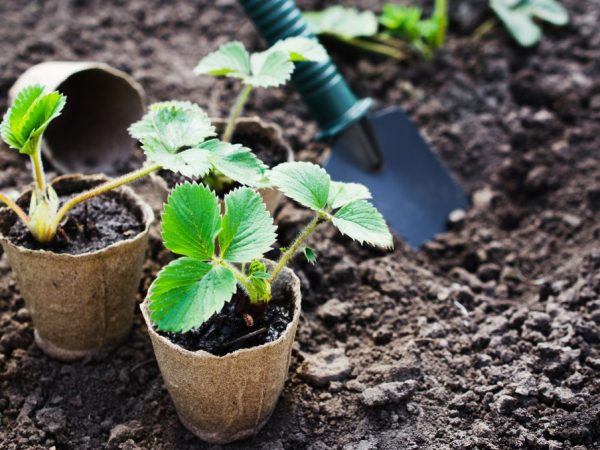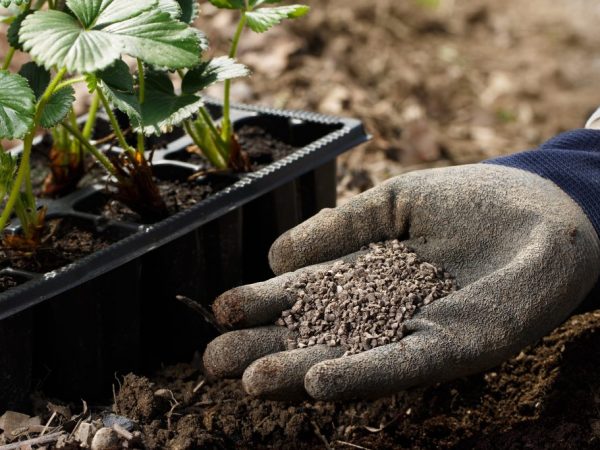How to plant strawberries in the fall
Planting strawberries in the fall is practiced by many summer residents. At this time, the root system receives enough moisture. If you comply with the terms and technology, you can with a high degree of confidence get a good harvest for the next year, not only in the southern, but even in the northern regions.

How to plant strawberries in the fall
Advantages and disadvantages of the procedure
The main advantages of autumn planting:
- a large percentage of survival of the root system;
- warming up the soil and preserving heat in the soil layer even with a sharp cold snap, with a uniform decrease in temperature;
- readiness of the soil fertilized over the summer;
- sufficiency of free space after harvesting of other cultivated plants;
- no need for thorough care;
- the opportunity to purchase high-quality planting material, because horticultural farms offer a wide range of products at low prices by autumn;
- abundance of natural watering.
Among the minuses noted by some summer residents are sharp frosts, due to which the planted bushes do not have time to adapt and take root.
Timing
Planting and replanting a berry culture in a new place in autumn begins from the first days of September, while taking into account the climatic conditions of the region. Some gardeners are additionally guided by the lunar calendar when choosing a date.
Regional features
The basic rule is that the ambient temperature is not lower than 10 ° C. Before the first autumn cold snap, there should be a time supply of 3-4 weeks. Long-term weather forecast helps to calculate the correct date.
For different regions, the landing time is different:
- in the Central lane and the Moscow region - the first half of September;
- in the South - mid-October;
- in the Urals, Siberia, the Leningrad region and in the regions of the Far North - late August-early September.
Lunar calendar
Optimal dates for 2019:
- August - from 2 to 8, from 11 to 13, from 17 to 18, from 26 to 28;
- September - from 1 to 5, from 7 to 10, 17, from 21 to 24.
It is not advised to land on the full moon and new moon.
Preparing bushes
It is better to buy strawberries in specialized horticultural centers, where a lot of attention is paid to treatments against pests and diseases. Such a purchase reduces the risk of infection of the ridges.
The quality of the planting material determines how quickly the plants will take root and what the harvest will be.
Seedlings come with an open root system (when the roots are in a container or a clod of earth) and open (the roots are free of soil), with a mustache and without a mustache. The best option would be closed, because it is easier to care for it, it has faster rooting and adaptation times in a new place.
When choosing varieties, one should take into account the regional characteristics of cultivation. Acquired species should be zoned. For the north, it is preferable to choose the remontant variety.

Choose healthy bushes for planting
For high-quality seedlings:
- green foliage;
- on the vegetative parts (stems, leaves, whiskers) there are no traces of mechanical damage and damage by diseases and pests;
- the number of developed leaves is not less than 3;
- the optimal root length is 7-8 cm, there are white branches;
- horns with a diameter of 0.7 cm or more.
You should not purchase planting material if:
- leaves are pale or shriveled;
- leaf blades, stems, whiskers are covered with speckled or spotted;
- traces of mold are observed on the aerial part or roots.
Before planting in open ground, seedlings are prepared to awaken biological processes and reduce stress from changing growth conditions:
- in a week, the seedlings need to be placed in a cool, shaded place;
- treat the roots with root stimulants.
Some summer residents plant bushes, cutting off 1-2 of the strongest leaves from them, because a large amount of moisture will evaporate from their surface. This will cause an increased load on the still immature roots, which are responsible for supplying the plant with water.
Site organization
When planting, you should avoid lowlands, swampy and shaded areas. The berry prefers good lighting, enough, but not too much moisture. The location of groundwater is no closer than a meter from the surface of the earth.
The optimal indicators of soil acidity are 5.5-6.5 pH.
Strawberry bushes show the highest yield on sandy or sandy-loamy soil, which is characterized by good aeration and lightness. The recommended humus content is up to 3%.
You should not plant strawberries in clay and peat: in the first case, the roots will begin to rot due to the dense structure of the soil layers and the lack of air permeability, and in the second, the risk of late blight increases due to the increased proportion of fluoride.
The most suitable for planting will be the one in which no plants have been grown for at least one season.
Best predecessors:
- salad greens;
- dill;
- parsley;
- celery;
- beans;
- garlic;
- corn;
- radish;
- turnip;
- bulbous flowers such as tulip, daffodil, marigold;
- root crops, incl. carrots, beets;
- White cabbage.
Tomatoes, eggplants, watermelon, melon, potatoes, raspberries, cucumbers, pumpkin seeds are not the most suitable precursors for strawberries.
The garden bed must be prepared in advance, 1-1.5 months in advance. It is dug up to a depth of 0.3 m as soon as the soil layer settles. For infertile soils, the digging depth is up to 0.2 m.
The landing site must be cleared of weeds. If plants susceptible to diseases and pests were grown before strawberries, the soil must be disinfected and fertilized with humus or manure.
Landing scheme

You need to do planting work in the fall
Strawberries are planted in the fall. The best time is a cloudy day without precipitation.
There are 3 main methods:
- Condensed. The distance between the holes is 0.2 * 0.6 m, the number of plants is up to 25 per 1 m²;
- Middle. The gap between the bushes is 0.3 * 0.6 m;
- Large. The distance between landings is 0.4 * 0.6 or 0.4 * 0.7 m.
Technology:
- form a hole to a depth of 0.3 m with a similar diameter;
- the seedling is placed in the center, placing the growth point - the central bud (heart) at the bush at the level of the ground surface;
- sprinkle the roots with dry soil, then moisten.
At the end of planting, strawberry seedlings are watered if no water was added at the stage of forming the holes.
Attention! When planting plants, the bush should not be deeply buried in order to prevent rotting. Too long roots must be shortened to 5-7 cm.
Planting according to the Kizima method
The method of planting strawberries in autumn from Galina Kizima is based on the free growth of plants without the formation of even ridges and row spacings. However, she advises:
- do not weed;
- do not trim the mustache;
- do not cut the foliage.
The growth is limited by digging along the perimeter of the beds or by installing a fence made of boards.
With this care, the main focus should be on watering.Top dressing can be reduced to 1 time in 3 years if the soil is fertilized before planting with a complex AVA compound (10 g / m²).
Instead, you can feed the strawberry bushes by foliar spraying over the foliage, as well as watering with an aqueous solution or scattering dry Azofoski. Consumption rate 1 tablespoon / 10 liters per m².
After 3-4 years, the yield decreases, the ridges are prepared for a new autumn planting:
- after harvesting, a layer of weed vegetation, straw, foliage is lined, forming a compost heap right on the site, for acceleration, it is watered with an aqueous solution of biological products such as Baikal and Vozrozhdenie, I put a black film or agrofibre on top;
- in the spring, the shelter is removed, the ridges are treated with biological mixtures with Fitosporin, Gumi and the like, diluting according to the instructions for the preparations;
- for the next autumn, fresh bushes with a mustache are planted in a prepared place.
Follow-up care
Fertilization
The berry culture is a phosphorus-loving plant.
Feeding with AVA helps to provide the right amount. Application rate - 1/3 tsp. for each hole before boarding.
Replacing the finished AVA preparation can be supplemented with superphosphate with a potassium component (for example, potassium sulfate) in the calculation of 1 tbsp and 0.5 tsp, respectively, per 1 m². The mixture is scattered dry.
Additionally, strawberry bushes are fed with wood ash. Application standard - 50 g / m².

Top dressing saturates plants with microelements
Also, when choosing fertilizers, you can be guided by the structure of the soil:
- for loamy, humus, manure, compost (2-3 buckets per m²) or nitroammophoska (2 tbsp / m²) are suitable;
- for sandstones, manure or humus is applied at 20-30 l / m²;
- turf requires sawdust up to 4 kg / m²;
- for heavy clay - river sand with manure, 4 and 3 buckets, respectively, per m².
The acidity of the soil is regulated by peat and limestone with ash:
- limestone (dolomite) flour or wood ash is added to low-acid ones;
- peat is added to acidified ones at the rate of 10 kg per m², the peat component is replaced with coniferous litter.
The last subcortex should be in the second week after planting. If the berry grown in the greenhouse is fed throughout the winter, then the one planted in the open ground in the fall is first fertilized in the spring, then in the flowering phase and at the end of fruiting.
Pruning
The green mass is built up in 2 stages:
- from spring to the end of fruiting;
- after the berries ripen.
Autumn pruning of foliage and mustache grown on the first wave is done immediately after harvest.
Leaves and whiskers that appear after the fruiting stage are left to protect from frost.
Preparing for winter
To avoid freezing, the berry culture, especially in the northern regions, is covered for the winter.
For protective purposes, they use both covering non-woven materials (film, agrofibre), and natural ones - ash, needles, compost, peat and sawdust, evenly distributing them in a layer up to 5 cm under the stems.
Such procedures will help to retain moisture and prevent the appearance of an earth crust, which acts as an obstacle to air penetration.
Summing up
Not only spring, but also autumn is the right time for planting garden strawberries in open ground. If you purchase high-quality seedlings and follow all the rules of technology, protect the plants from freezing in winter, using a covering material - agrofibre, black film or natural ingredients, even novice gardeners will be able to get a good harvest of berries next season.

